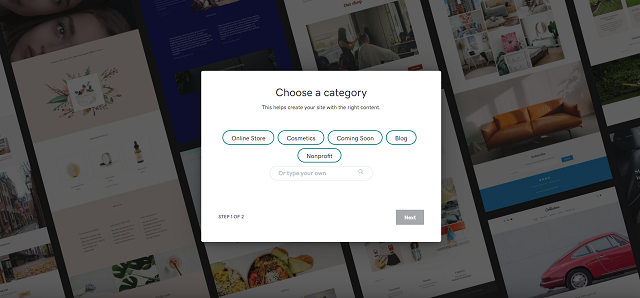Looking to start a website? It’s no secret that nearly 5 billion people across the world have access to the internet. From mobile devices to desktops, it seems like everyone these days is plugged in — and if your business isn’t claiming space on the web, then you’re missing out on oodles of potential customers. No matter your niche or where you’re located, it’s essential to start a website for your business.
With a website, you can sell products or services online, establish yourself as a thought leader in your industry, generate new leads for your business, reach and connect with customers, and give your brand the visibility it deserves.
Are you on board yet? Good, because having a website is important, but building one that suits your needs and is functional for potential visitors is the end goal.
Editor's note: Want to get a head start on building your website? Websites + Marketing is here to help.
Start a website in 5 steps
For the remainder of this post, we’ll cover everything you need to know to build a highly effective website — from getting started by establishing achievable goals, to creating a content-rich website that both visitors and search engines will love. We’ll take a look at what you need to know to sell online. We’ll introduce tools that will help you achieve your website goals. And we’ll divvy out tips and best practices to make your website work at maximum capacity.
- Plan your website.
- Design your site — DIY or DIFM?
- Create amazing content.
- Sell on your website.
- Get found with SEO.
Now that you want to start a website, we want to help you succeed. Ready? Let’s go.
1. Plan your website

Before you can dive into the nitty-gritty of website creation, you need to map out a plan for success. Even if you already have an established brick-and-mortar store, taking that identity to the web requires a bit of foresight.
Establish concrete goals
If you’re looking to break into the online scene, you’ll first need to define your purpose. It’s not enough to say, “I want to sell online,” or “I want a website.” Rather, ask yourself, “What do I want my website to accomplish for my business?” Perhaps it’s revenue or monthly visitors. Regardless of the metric you choose, make sure it aligns with your overall brand.
Crafting measurable, attainable goals gives you a way to track your company’s success. Instead of saying, “I want a million followers on Twitter by the end of my first year,” break it down into quarters (and maybe start with a smaller number).
Not sure where to start? Here are some things to consider:
- Keep your goals realistic.
- Make sure they’re well-defined.
- Align them with your business’s mission.
- Ensure they’re measurable.
- Set a time limit for each goal.
The purpose here isn’t to confine or stifle you — there’s merit in dreaming big. But if you set lofty goals before you have the platform to achieve them, you run the risk of low morale, which only hinders your output. And remember, you’re building this site to put your business in front of billions of online users. Clearly defining your goals ahead of time makes it easier to connect with your target audience.
Define your audience
As appealing as it sounds to cater to the three billion users online, it’s not reasonable. Those three billion users are unique individuals with tastes that vary wildly, so you’re better off targeting people who closely align with your business’s niche in the marketplace. It’s important to get granular with your online presence so you can better connect with potential consumers.
What kind of site are you building? Do you want to be humorous or serious? Are you selling mint-condition bobbleheads or offering legal advice? Knowing who your audience is, and appropriately tailoring your language to their needs, means you’ll have a better chance of encouraging them to act — and by that we mean buying, subscribing, sharing or whatever your desired end result might be.
Pique your audience’s interest

Let’s say you want to start a website to sell custom printed T-shirts with wacky images and humorous catchphrases. How are you going to appeal to customers — both existing and new — when it comes to your products? You probably wouldn’t lean on dry text when trying to describe your fun logos. Let’s take a look at two options and see which one you’d prefer:
Option 1: Try our cotton-blend men’s T-shirt. Sixteen different colors available in six sizes, ranging from XS to XXL. Features a cute sneezing panda on the front.
Option 2: Woven with the craftiness of Rumplestilskin himself, these comfortable T-shirts will softly caress your skin for a guaranteed 24 hours. The sneezing panda will definitely make you an internet sensation — for a limited time.
Which do you think your audience would prefer? Why are they visiting your site? But most importantly, which option will encourage your consumers to act? It’s not the same for every business, so don’t be afraid to test out different methods until you land on the right one.
Define your audience
Complete the following fields to get a better picture of who your target audience is:
- Age and gender: (i.e., Women over the age of 20)
- Interests and hobbies: (i.e., Skateboarders)
- General location: (i.e., Northeastern states)
- Personality and attitude: (i.e., Humorous)
- Occupation and income: (i.e., College student, less than $40,000 a year)
This combination of demographic and psychographic information will help you narrow down your audience, even giving you the opportunity to tailor content and potential products to make acting — buying, sharing, subscribing — easier for consumers.
Pick a domain name
Picking a domain name isn’t to be taken lightly. Whether you’re starting a brand-new business or already have an established company, one thing stands true for both — your domain name should represent your brand. And since there are almost two billion websites currently on the internet, that means finding the perfect domain name might be a tad difficult.
Don’t limit yourself by looking only for domains ending in .com. There are hundreds of new geo- and industry-specific domain extensions that can help you score a domain name that perfectly represents who you are, what you do, and where you do it.
If you’re starting an ecommerce site, consider a domain name ending in .shop or .store. Attorney? Check out .legal and .lawyer domains. In the pet services industry? Snag a domain name ending in .pet. Plumber? There’s a .plumbing domain name that’s just right for you. The sky’s the limit with the availability of these new generic top-level domain extensions (gTLDs).
Above all, an effective domain name should do the following things for your business (regardless of the extension you choose):
- Safeguard your brand.
- Accurately represent who you are and what you do.
- Grab the attention of your visitors.
Simple, right? Let’s take a look at some helpful tips for choosing the perfect domain name.
10 tips for choosing the perfect domain
- Make it easy to type. You don’t want your visitors ending up somewhere else because you added a silent “T” to your name.
- Keep it short. Supercalifragilisticexpialidocious is better left to Mary Poppins.
- Use keywords. If you can, incorporate the product or service you offer.
- Target your area. Consider using your geo-location to your advantage.
- Avoid numbers and hyphens. These keys aren’t typed as frequently as the alphabet — don’t make people work to find you.
- Be memorable. Standing out from the crowd is good thing.
- Research it. Don’t grab the first name you think sounds catchy — test among your friends and family first.
- Use an appropriate domain extension. Don’t get stuck in the .com mindset.
- Protect and build your brand. Consider registering multiple variations to safeguard your brand.
- Act fast. New domains are registered every day — don’t wait too long, or yours might get snatched.
Want an in-depth understanding of each step? Check out the full article here. And when you’re ready to start searching ...
Go for it!
SEARCH
Research design ideas
So now that you’ve established your goals, determined your audience, and selected a domain name, it’s time to create, right? Almost. Before you pick up the design tools and start a website, do some recon.
A good place to start is by looking at your competitors’ websites. Pay attention to:
- The fonts and colors that appeal to you.
- The layout and overall feel of the site.
- The use of videos, images and other graphics.
- The amount of pages present.
- The amount of copy or text on each page.
- Whether or not it’s easy to navigate.
- Whether or not it’s optimized for mobile devices (all of them should be).
Do these sites feel clunky or clean? Will the end-user be able to navigate easily through the site so they can perform the desired action? Overall, your goal is to note what works and what doesn’t so you can make educated design decisions moving forward. Make a list of your favorite design elements and keep them close at hand so you’re ready to move to the next step.
Remember: Trends change rapidly. Be prepared to revisit your site every few years to make sure it’s on par with industry standards.
Quick checklist: Plan your website
Let’s recap your first few steps for starting a website:
- Write down your business goals.
- Define your audience.
- Brainstorm domain names.
- Search and register domain(s).
- Research design ideas.
- Make a list of favorites for reference.
Time to plan a website: 1 to 3 hours.
2. Design your site — DIY or DIFM?
So by now, you totally understand that building a website for your business is important and you’ve nailed down the planning fundamentals. But what do you do next? The good news is, you have options. You can either start a website yourself (DIY) or hire a professional to do it for you (DIFM). But before we weigh the pros and cons of those avenues, let’s first talk about the foundation of your website — your hosting.
Consider your hosting options
Imagine your website as a house. Your domain is the street address, and the plot of land beneath your structure is your hosting plan.
No matter how solid your house is, if the foundation beneath it is weak, you’re going to run into problems.
A good hosting platform, regardless of whether you build a website yourself or hire a pro to do it for you, is essential for solid performance. Whether you opt for a simple DIY website builder or use a Content Management System (CMS) like WordPress, the behind-the-scenes hosting needs to be up to snuff.
Before purchasing a hosting plan, here are a few things to consider:
Reliability. Even if your site is optimized for speed, your host’s uptime could affect your site’s load time and accessibility. Pay close attention to the guarantees each company offers.
Support. What happens when your site goes down at 2 a.m.? Will you be able to reach your hosting provider, or will you have to wait until the following day to find a solution? That valuable time off the internet could potentially hurt your business. Look for a provider with 24/7 support.
Storage. Storage is largely dependent on the type of site you’re going to build. Are you a photographer in need of displaying your online portfolio? If so, those images are going to use a lot of space. While some places offer “unlimited” storage, be sure to read the fine print.
Bandwidth. Bandwidth and storage go hand-in-hand. The larger website you have, the more data you’re going to transfer to visitors upon arrival, and the more bandwidth you’ll need.
Scalability. We all want tons of traffic, right? Right. Make sure your hosting company can handle your expected amount of visitors. The last thing you want is an influx of traffic only to have your site crash.
Security. Getting hacked is no joke. Malware and viruses can seriously damage your online reputation. Look for hosting plans that either incorporate some level of security or companies that offer website security as an add-on.
Backups. Unexpected problems happen all the time. If something goes wrong with your site, you can use your backups to restore it. Check to see if your hosting provider offers website backup (GoDaddy does) or a way to add them to your plan.
Note: If you opt for a site builder, most companies include hosting as part of their package. Check to be safe so you don’t buy products you don’t need.
Build your site: DIY

Now it’s time for the fun stuff — building your website. There are a couple of different ways to go about it if you’re looking to build a site yourself, but for the sake of this article, we’ll narrow it down to two of the most popular options: using a website builder or WordPress.
WEBSITE BUILDER
If you consider yourself non-technical and you don’t have the funds to hire a professional, then a website builder is the way to go. Consider a tool like GoDaddy’s Websites + Marketing. Add pictures, customize pages, integrate with Facebook, add email marketing and more — all with an easy-to-use swipe-to-style interface. You can even build your site on your mobile device in under an hour. Plus, Websites + Marketing automatically optimises your site for search engines to improve your ranking.
Our recommendation: Website builders are great for entrepreneurs and small business owners looking to establish an online presence quickly. They’re easy to use, require little to no technical knowledge, and are a great way to start a website.
WORDPRESS
If you want more flexibility and control of the behind-the-scenes aspect of your website, then WordPress is the way to go. Just keep in mind that WordPress requires a bit more technical skill than your go-to drag-and-drop builder. While you don’t need to learn coding right out of the box, there are hundreds of plugins, features and options that could provide added functionality if you’re willing to put in the time.
Over 34% of the internet has selected WordPress for their site-building needs, and there are tons of resources available to you.
With GoDaddy’s WordPress hosting option, you can dive into building with a simple and easy Quick Start Wizard. Before you know it, you’ll be online!
Our recommendation: WordPress is a perfect option if you’re looking for more customisation out of your website. There are thousands of plugins and widgets available to boost functionality. If you’ve got the time to tackle the slight learning curve, WordPress is a great solution for your business website.
DIY design tips
Keep these quick tips in mind when designing your site:
- Use a clean and simple design.
- Choose a color scheme that matches your brand or logo.
- Use high-resolution, quality images.
- Choose a font and style that’s easy to read.
- Make navigation clear and easy.
- Include well-crafted web content.
- Don’t forget a contact page.
- Make sure your site is mobile-friendly.
- Prominently display links to your social profiles.
- Optimise for search engines like Google.
Build your site: DIFM
If you would rather spend your efforts focusing on what you do best — running your business — and have a budget for website design, hiring a professional web designer might be the way to go. Just like you are the only person who can run your business, professional web designers possess a unique set of skills and talents they use to run theirs.
Want to put a professional team in charge of creating and managing a beautiful business website for you? If so, then GoDaddy’s Website Design Service is a great place to start. They’ll create, host and update your site quickly and affordably, so you can focus on what you do best.
Website Design Services from GoDaddy's Professional Web Services team lets you rest easy knowing that a modern, professionally designed website is within reach. With an average time of around 4-6 weeks to complete a website, the Professional Web Services team will work with you to understand your schedule and needs.
The design team will also ensure that your site is fully optimised for search engines and will also manage your business social media accounts as well. Additionally, unlimited site updates are built into most plans, so your website can be easily kept up to date.
Once you've selected the Web Design Services plan that best fits your business needs, you would then choose a theme that fits your business and give your web designer the basic information about your site. With a website from the Professional Web Services Team, you simply provide the content and images; they handle everything else.
If you don't have any images, no problem. The Professional Web Services team can insert professional images that will fit your site perfectly. With GoDaddy's Web Design Services, you'll get a beautiful, functional website that fits your style and your needs.
Quick checklist: Design your site
Ready to move on to the next section? Make sure you’ve completed these tasks:
- Determine DIY or DIFM
- Compare options using worksheet
- DIY: Site builder or WordPress?
- DIFM: Research/hire a pro
Time to design your site: A few days
3. Create amazing content

Whether you want website visitors to sign up for a newsletter, purchase a product, share on social media or anything in between, you need to present content that compels them to act. Well-crafted words, paired with eye-catching images, can make all the difference. That’s how you make your story shine online.
Your business story
Even if you don’t fancy yourself a skilled writer, you can craft amazing content that speaks to your business and your brand. That content can be as simple as:
- Sharing how you started your business.
- A photo or video of you / your team in action.
- The methods behind building your products.
- Interesting descriptions of your services.
- An anecdote that demonstrates how your products or services are benefiting customers.
The choice is yours. To start, all you need is content for five core pages (you can always expand later).
Five core pages
Home. This is your landing page, and it needs to wow visitors from the get go. Craft content that invites visitors to explore further and encourages them to act.
About Us. There’s no better place to tell your business story than on your About Us page. Explain how you got started to show your visitors the people behind the brand.
Products/services. The bread and butter of why you’re starting a website. Remember that images, as well as content, paint a story. Make sure any product photos you use stand out.
Testimonials. It’s important for visitors to see that your product and brand can be trusted. Use testimonials to share the customer perspective of your business.
Contact Us. Give your visitors a way to contact you. Show them that you can be reached, answer questions promptly, and inspire trust by being more than a brand.
Write your own web content
Now onto the really fun stuff — writing your own web content. Don’t fret! No one knows your business better than you. You know your story, you have a unique voice, and you can inspire trust in customers, regardless of your previous writing skills. Crafting content doesn’t have to be difficult, and we’ve got a few tips to steer you in the right direction.
Audience. If you haven’t done so already, nail down your audience. Understanding the type of visitors you intend to engage with is key to creating relevant content. Prioritize your content to match with their unique needs, and make sure your content not only explains what you do, but why you’re the better option than your competitors.
Voice. Once you’ve determined your audience, you can tailor your voice to match both your brand and your customers. You wouldn’t run a law website and use humorous language to describe divorce proceedings, and likewise if you’re selling fun kids T-shirts, you wouldn’t use stiff text to describe your products. Be true to your brand, and the rest will naturally fall into place.
Layout. Do your eyes glaze over when you see a big block of text? Mine do. The layout of your content is just as important as the words themselves. Use images, white space, lists and headings to spread out your information in a way that is pleasing to the eye.
Have fun! This is the most important step — have fun with your words! Don’t be afraid to test out different methods and go with the one that works best for your customers (and you).
Pro tip: When you’re done with your web content, get an outside pair of eyes on your words (preferably someone with editing experience). Even with a humorous site, you want to be professional, so don’t let grammatical or mechanical errors hold you back.
Using images on your website

Part of a standout content strategy includes incorporating captivating images. In fact, “BuzzSumo found that articles with an image once every 75 to 100 words received double the social media shares as articles with fewer images.” So if you want your readers engaged, start including images. Here are a few things to remember when it comes to selecting photos for your website:
Don’t use images illegally. You can’t just run to Google and copy the first photo you see. Stick to places like Pixabay or Unsplash for stock photos if you don’t have the means to take your own. Provide attribution as needed.
Use high-quality images. Beautiful images can inspire action. Don’t turn customers away with shaky photos. Pick or take photos that relate to your brand and resonate with your audience.
Optimize your images. Keep reading through this guide to learn more about image optimization. For starters, make sure they’re sized appropriately, compressed so they don’t affect load time, and are named with relevant keywords.
Outsourcing web content
Still not convinced that writing your own content is the way to go? Consider outsourcing. There are plenty of sites, like UpWork or Fiverr, that make it easy to hire a freelancer for your content needs.
Pros:
- There are plenty of options, giving you the ability to be selective with who you hire.
- You can specifically choose someone with writing and editing skills.
- You have the option to post your job and set your budget on your own terms.
- Hiring a pro gives you more free time to handle other business tasks.
Cons:
- Hiring an outsider to tell your story might not result in your desired voice.
- You might have to revisit the final product and add some of your own personal flair.
- Hiring someone is always more costly than writing content on your own.
- You’ll be relying on someone else to meet a deadline (rather than yourself).
Pro tip: If you decide to hire a pro, arm them with insight about your business from the get-go — how you got started, inspiration behind the products, etc. The writer’s job is to work with the raw material you provide.
Putting it all together
Now it’s time to put it all together and start a website. Let’s do a quick walkthrough and see what kind of site we can build in under an hour with GoDaddy's Websites + Marketing.
- Start with a free trial.
First, head on over to GoDaddy and sign up for a free trial — don’t even bother pulling out your credit card. No plastic required! And, you can cancel at any time if you don’t like the product.
- Select your business category.
What’s your niche? Search through more than 1,500 categories to find the one that aligns with your business.

- Start designing.
It’s really that simple. Browse through images (if you don’t already have your own), drop in the content you drafted from the creation worksheet, browse different layouts and color schemes — even add new features or pages (like a Calendar, Blog or Contact form) with ease.
- Publish your work.
Satisfied with your design? Be sure to Preview your creation first, but once you’re ready, all you need to do is hit Publish. Bonus? It’s automatically optimized for mobile devices, so no matter where your customers are — or how they access your site — your creation will render beautifully.
Quick checklist: Create amazing content
Ready to keep going? Let’s double-check:
- Outline your website’s pages
- Determine: DIY or hire pro
- Planning to DIY? Complete Content Creation Worksheet
- If DIFM is your choice, write a FAQ about your business
- If DIY, add your content to your website
Time to create your content: A few days
4. Sell on your website

Whether you already have an established brick-and-mortar store or you’re jumping right into the ecommerce scene with a new business, selling products or services online is a great way to attract new customers. You don’t have to rely on foot traffic to sell your wares, and there are plenty of options for getting customers through your virtual door.
An ecommerce website is a powerful tool for generating profit and expanding your reach, putting your brand at the forefront of customers’ minds.
Your customer base just expanded to cover the globe. And while you might not target every person on the internet (you’ll definitely want to keep your industry niche in mind), you’ll need to include certain elements on your ecommerce site to attract and retain customers.
Compelling product images and descriptions
Your wares are the bread and butter of your online store. It’s not enough to simply post a picture and a price — all of your product images should be high-quality photos with an accompanying description that explains features and benefits.
When it comes to taking product photos, here are some tips to keep in mind:
- Use the sun or natural lighting if possible.
- Shoot from different angles to showcase your products.
- Consider using some accessories (tripods, flashes, etc.) to get the best shot.
You don’t need to drop tons of money on photography gear. If you’ve got a smartphone, you can take great-looking images right from your mobile device. Just keep background, lighting and your audience in mind.
When crafting product descriptions, audience and tone are key. Listing features is a must, but it’s also important to sell the experience of owning your wares.
Too often businesses only focus on the features or specifications (size, color, texture, etc.) and completely forget about the benefits.
Keep your ideal buyer in mind and tell them why they want the product. Those organic soy candles are great, but they’re even better because they invite warmth and promote relaxation with their soothing aromas.
Payment methods
Depending on the type of site you have, your payment processing method will differ. We’ll cover options for both a site builder and WordPress here shortly, but here are a few key overarching things to keep in mind:
- Offer multiple payment options.
- Make the purchase path clear and easy to navigate.
- Ensure customers can apply coupons and discounts.
Customers who struggle to navigate through the checkout process often abandon their carts. Make sure your layout is streamlined, and give them plenty of options (credit cards, debit cards, PayPal, etc.) for purchasing.
Pro tip: Use an SSL to secure your online store. Protect your customers’ information to help build the trust that will encourage future purchases from your ecommerce site.
Shipping
Want to further reduce cart abandonment? Make sure your shipping setup is solid, and if you can, offer free shipping. According to the Walker Sands Future of Retail report nine out of 10 people (in a survey of 1,400) indicated that free shipping was the No. 1 incentive for shopping online. That’s an astonishing percentage of shoppers you could capitalise on simply by wrapping shipping into the cost of your goods.
If free shipping isn’t in the cards, you can always opt for a flat-rate or weight-based price. Free might still be the best option, but whatever you do, make sure the method serves your customers.
Terms and conditions
No matter what you sell, it’s important to include terms and conditions on your website. Terms and conditions protect both you and the buyer — you get to dictate how processes are handled on your site, and your customers aren’t left in the dark. A comprehensive terms and conditions page or section is a great way to instill confidence in your buyers.
Not sure what to include? The specifics might vary among industries, but to get you started, here are a few common topics that appear in terms and conditions:
- Special fees and taxes
- Refunds and returns
- Shipping policies
- Copyrights and intellectual property
- Disclaimers
- Cancellation clauses
Do some research and determine what to include in your terms of service or terms and conditions section. Just remember — update your terms and conditions frequently to reflect business changes.
Testimonials

Each satisfied customer equals the opportunity for a five-star testimonial. Testimonials serve to prove to potential buyers that your product works, and since they’re not directly benefiting from leaving positive feedback, their opinion is trustworthy.
You can’t afford not to use customer testimonials to establish credibility for your business. Don’t be afraid to ask your customers for reviews — you can either develop questionnaires or reach out post purchase. Just remember, tailor your questions so your customers explain how your product or service is solved for a need. Also, be sure to let your customers know you’ll want to share their feedback.
Design with ecommerce in mind
Now that we’ve covered the basics for your ecommerce site, it’s important to consider how you’ll put it all together. When building an online store, here are 10 design elements to consider when creating your site.
- Clear, concise and engaging calls-to-action.
- Clean layout and design.
- Simple navigation.
- Intuitive checkout process.
- Contact page for customers to reach you.
- Easy-to-use product catalogue.
- Colors and logos that match your brand.
- Responsive and mobile-friendly.
- Signup form to keep buyers in the loop.
- Links to social media profiles.
Selling with Websites + Marketing Ecommerce
Building a website to sell products doesn’t have to be time-consuming and difficult. You don’t need to navigate a matrix of code or learn the finer points of CSS to create a beautiful online store that converts browsers to buyers. If you’re running a business, you likely don’t have the time or inclination to build a fully custom ecommerce site. That’s normal.
But you want your online store to showcase your products to maximum effect, be easy to manage, and move customers smoothly through the checkout process. You can achieve each of these online store goals (and more) with GoDaddy’s Websites + Marketing.
With Websites + Marketing, you can quickly launch a beautiful online store with an integrated shopping cart that’s automatically optimized for our mobile world.
The setup is intuitive and fast — just the kind of thing on-the-go entrepreneurs need. Just start the free trial, associate your domain name with your site, pick a template, and start styling. Once you’ve done that, your online store is just a publish button away from millions of potential customers.
Must-have features
Because we know it’s not enough to simply have a website, we packed Websites + Marketing with tons of features every ecommerce business needs.
Professional designs and images. Not a designer? No problem. We’ve done the work for you. Our research is industry-specific — you just enter your idea or business, and we’ll suggest features, content and images to go along with it. And while you might want to take your own product photos, you’ll have plenty of high-quality stock options at your fingertips, too.
Email marketing integration. Reaching customers is your No. 1 priority. You want to engage with your fans and welcome them back to keep retention high. Websites + Marketing's built-in email marketing tool means you can create a Subscribe Now section to encourage customers to stay in touch. Then, build lists, start campaigns and track success.
Mobile-ready technology. We do everything from our phones, and creating a smooth and streamlined purchasing process, on multiple devices, is a must. Good thing Websites + Marketing automatically does that for you.
Multiple payment methods. PayPal. Credit cards. Debit cards. Even Apple Pay. Websites + Marketing allows for a handful of payment methods to make transactions easier for your customers. The last thing you want is an abandoned cart because purchasing products is too hard. But with all these options, it won’t be a problem.
Built-in SEO tools. Now that you’ve got a beautiful site, it’s time to attract customers. Stand out from the crowd by using Websites + Marketing’s built-in SEO tool to optimize your site for success. From Google to Yahoo and Bing, you’ll be sure your content is optimized to boost search rankings.
Selling with Managed WordPress
For a more robust ecommerce site that doesn’t require a degree in web development, check out GoDaddy’s WordPress Hosting. You can choose from thousands of WordPress plugins to truly customize your site, and with our Quick Start Wizard, you can have an ecommerce site up and running in no time.
The Quick Start Wizard in WordPress Hosting will guide you through the process of selecting a professionally built theme with placeholder content and images that you can easily replace to customize your site.
Plus, there are plenty of features. With GoDaddy's Wordpress Hosting, it’s easy to:
- Start a blog (now or in the future).
- Get listed on Google with the help of plugins like Yoast.
- Integrate your social media accounts and add social icons to your site.
- Accept multiple payment methods.
- Build a solid email list using the built-in signup form.
- Schedule appointments … and more.
Even better? GoDaddy handles all the technical stuff for you. Just stay focus on the steps to start a website!
WordPress + WooCommerce
There’s so much to do on WordPress, but since we’re here for the E-commerce element, it’s imperative we talk about WooCommerce.
WooCommerce is a powerful E-commerce solution that integrates beautifully with WordPress.
And with GoDaddy's WordPress E-commerce Hosting plans, you can get WordPress hosting services with WooCommerce preinstalled, along with $3000 worth of free plugins included.
WooCommerce is a robust plugin. In fact, there are more than 400 extensions you can use to tailor the functionality of WooCommerce to your needs. If this is your first go at an E-Commerce store, then there’s no need to wade through all those extensions. First step? Narrow down your needs. Consider things like:
- Packing slips
- Multiple shipping methods
- Integration with email marketing
- Inventory and stock management
- Advanced shopping cart functionality
Most of the functions allow for a freemium trial, so test a few out. As long as you’ve included WooCommerce in your WordPress plugins, the extensions will be available to you. After that, read on to see some of our favorite features.
Quick checklist: The E-commerce element
Feeling good about your E-commerce setup? Let’s do a quick recap:
- Create product descriptions and photos.
- Determine shipping and payment.
- Include Terms & Conditions and testimonials.
- Note E-commerce design elements.
- Explore Websites + Marketing or WordPress
Time to add e-commerce features: A few days
5. Get found with SEO

Now that you’ve got a website, you’ll need to work on gaining visibility in the highly competitive cyberspace marketplace. There’s where search engines like Google and Bing come into play. It’s not enough to simply establish an online presence — you’ll need to apply the basic principles of search engine optimization (SEO) to your website to get found online.
The good news? You’re already a big step ahead by creating relevant web content — the kind of content that will appeal to people who are searching the web for your kind of products and services. Stay on top of your content game, and you’ll be well on your way to a website that attracts visitors. Now, onto SEO.
SEO is the process of increasing web traffic to boost the ranking of your website when it is indexed by search engines like Google.
We’ve all heard the popular saying from Field of Dreams — “If you build it, they will come.” Unlike a magical baseball diamond in the middle of a cornfield, creating a website won’t automatically call to baseball heroes (or any visitors, for that matter). Fortunately, we’ve got a few tricks up our sleeves to help you out.
How SEO works
SEO is all about establishing yourself as an authoritative resource on the web. In order to do that, you need to understand the basics so you can better target your audience and increase your search ranking. At a high level, the basic elements of SEO you should understand and apply are:
Page content. We’ve touched on this already, but good content reigns supreme on the web. If you can answer the questions your audience is asking, you’ll rank higher in search results.
Keywords. Choosing appropriate keywords can make all the difference. Select phrases that pertain to your business. We’ll discuss this more in-depth shortly.
Link building. From backlinks to internal links, it’s important to link to appropriate related content to provide relevant and useful information to your visitors.
Image optimisation. There’s a lot to cover when it comes to using images for SEO, so keep reading to learn more (hint: you want your ALT text to match your designated keyword).
Meta tags. These tags contain pertinent information to help search engines describe your site in search results. Read on for a more detailed explanation.
Site navigation. The easier it is for search engines to navigate your site, the higher your ranking will be. Make sure all links are up-to-date and navigation is simple.
Site map. Just like it sounds, a site map is a map or directory of all the pages on your website. It’s used to guide search engines through your site.
Keywords
Picking keywords for your pages doesn’t have to be difficult. You just need to keep a few things in mind to strategically use specific words and phrases to help increase your search ranking.
Think like a customer. Use a tool such as Google Keyword Planner to research keywords your audience will be searching for.
Be specific. There’s no benefit to setting “shoes” as a keyword for your boutique shoe store. Location, services, products, industry — the more specific you can be, the better.
Use them naturally. Gone are the days of stuffing keywords just for the sake of stuffing keywords. Use phrases naturally, and don’t force them.
Once you’ve done all of these things, naturally include your keywords throughout the copy on your pages, in headlines and in titles where applicable. And remember to include them in your metadata or images names!
How to optimise images

Images are the opportunity to tell your brand story in a matter of moments. You already know how important it is to strategically select pictures that reflect your company, inspire engagement, and emotionally connect with your audience, so now it’s time to make sure those images are connecting with Google, too.
- Make sure your image file name contains the designated keyword for the page. If you’re selling “bedazzled flip flops,” use the file name, “bedazzled-flip-flops.jpg.” Keep your file name lowercase, and separate the words with hyphens.
- Designate your Image ALT Text to reflect your chosen keyword. Using the example above, it would be “Bedazzled Flip Flops.” Capitalized, no hyphens.
- Ensure your page text correlates with your image file name. Search engines look at both to deem relevance and ensure that the image in question really is about bedazzled flip flops.
Pro tip: Resize your images or use a compression tool to decrease page load time. Also, a DPI of 72 is plenty for online browsing.
Tag a friend!
Tags play an important role in getting found online. Get to know these three key tags to make Google happy.
Title tags. Title tags accurately and briefly (65 characters or less) describe the contents of the page to search engines and users. They display in two places: the bar of the internet browser and in search results.
Meta description tag. This is a short snippet (150 characters or less) that gives you the chance to quickly describe the nature of the content found on that page. It should include the primary keyword and entice readers to click through.
Header tags. Simply put, these are headers found throughout your page (H1s, H2s, etc.), and they should contain your primary keyword. While it doesn’t display in search results, it draws readers’ attention to the nature of the content.
How to get backlinks to your website
Backlinks are important to the success of your website, so it's important to plan for that when you start a website. It’s easy to internally link across your website to relevant information, but what about external links? Better yet, how do you get links from other websites to your website (aka backlinks)? While there are many strategies for garnering backlinks to your site, here are three to get you started:
- Offer to guest blog. As a business owner, you have industry-specific knowledge to share. By contributing to blogs in your niche, you create the opportunity to include relevant links back to your own website.
- Contact influencers. One great way to create backlinks is to ask an influencer to write a review about your products or business. They should already have an established following who trust their insight, which bodes well for you.
- Write testimonials. When you submit a testimonial to a business website, you’re often provided with the opportunity to link your own site. It’s easy to write about something you love, and most companies will reward you with link placement.
Local SEO
Local SEO is a fantastic way to drive traffic to your business, especially if you’re operating a brick-and-mortar venture. There’s a lot of noise out there concerning SEO best practices for improving your local ranking, so be sure to do your research beforehand. Straight from the source, here are some key tips to keep in mind, courtesy of Google:
- Create a Google My Business profile.
- Completely fill out your information.
- Regularly update your business hours.
- Verify your business location.
- Manage and respond to reviews.
- Add business photos for visual appeal.
- Check out other online map services and directories to claim your business.
Paid advertising
Want to take your journey a step further? Consider using paid advertising for your business. But what exactly is paid advertising?
Paid advertising is any form of advertising where you pay for ad space in order to display business information when you start a website.
Where paid advertising appears depends on the medium you use, but typically paid advertising appears in a prominent location above or before organic results. Take Google, for example. When you search for certain products or services, you might see the first few spaces with a green “Ad” box next to the link. These primary results are reserved for businesses who’ve paid to have their information appear first. There are two popular types of paid advertising: pay-per-click (PPC) and cost per thousand (CPM).
Just like their name implies, PPC ads are only paid for when someone clicks on them. Cost is determined by the value of the keyword or impression. CPM ads are paid for via a flat rate, regardless of whether or not someone clicks on them.
PPC vs. CPM
Both PPC and CPM ads can work for your business, you’ll just need to weigh the pros and cons of each to determine which one suits your needs best.
Pros (PPC):
- Easy to track success
- You only pay for the ads browsers click on
- You can modify your budget for ad spend with ease at any time
Cons (PPC):
- Costs can rise as you’re competing against others in your niche
- A click doesn’t automatically translate to interest
- It’s hard to track conversion, and you’ll need a reliable attribution model
Pros (CPM):
- Relatively inexpensive
- Makes budgeting easy as it’s one cost
- Guaranteed to display the number of times you paid for
Cons (CPM):
- Cost is set regardless of clicks, which means if no one clicks, you could overspend
- It’s easy for visitors to ignore banner ads
- Ad blockers can cause a loss of impressions
There are a few different ways to utilize ads for your business, so do your research first. Don’t be afraid to test out a few campaigns so you can determine which method works best for your audience.
Quick checklist: Get found with SEO
Boosting your SEO is a big undertaking. Let’s take a quick look at what we discussed:
- Incorporate appropriate keywords.
- Find ways to get backlinks.
- Optimize images.
- Adjust tags.
- Look into local SEO.
- Consider paid advertising.
Time to plan for increased traffic: 3-5 hours to set up, then ongoing
Next steps

Congrats! You’ve made it through the initial steps to start a website. But this isn’t the end — there’s so much more you can do to improve your site’s success.
Set up a business class email
It’s incredibly important to have a professional email address that matches your business name. A business-class email address inspires trust and shows visitors that you’re serious about your brand. If you don’t already have one, you can get an email that aligns with your domain name from GoDaddy.
Get familiar with email marketing
Email is still the most cost-effective form of marketing, and the potential ROI is well worth the time it takes to make a newsletter. A strong email marketing campaign keeps your followers in the know, spreads product awareness, and humanizes your business.
Look into social media marketing
Nowadays, if you’re not on Facebook, Twitter, Instagram or some other form of social media, you’re missing out. It’s important to stay social. As a small business owner, there are plenty of opportunities to engage with your followers and increase brand awareness.
Editor’s note: Check out GoDaddy's Digital Marketing Suite to keep your customers engage.
Consider blogging
We mentioned this briefly earlier in this guide, but it warrants being revisited again. Blogging is great for SEO and establishing yourself as a thought leader. Do plan for this when you start a website.
Google Analytics and site testing
There’s always room for improvement. Use a combination of Google Analytics and heat maps to measure your success and take stock of what works and what doesn't. Then, pivot.
Online security
Now that you’ve got your site up and running, you need to protect it. You’ll want to get an SSL to protect your customers’ information — as well as help with your search rankings — and then you’ll want to take steps to protect your website from malware, viruses, hackers and more. Investing in website security is a great option.
Want even more information about building your small business? Stay tuned to the GoDaddy Blog. We regularly add new content to help entrepreneurs and startups on their business journey.
Good luck on your journey to start a website!
This article was originally published on Feb. 22, 2018, and updated on Feb. 1, 2021.






